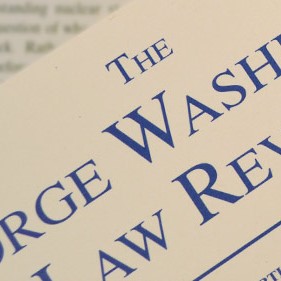David H. Gans · April 2008
76 GEO. WASH. L. REV. 639 (2008)
Severability doctrine has been with us since the beginnings of judicial review, yet it remains shrouded in mystery. The doctrine is simple enough to state: it allows a court to excise any unconstitutional clauses or applications from a statute, leaving the remainder in force if the legislature would prefer that result to the statute’s total invalidation. This makes possible as-applied adjudication and allows a court to save as much of a statute as it possibly can.
But severability doctrine is getting harder and harder to ignore. Three years ago, in United States v. Booker, a sharply divided Supreme Court invoked severability doctrine in revising the Federal Sentencing Guidelines, converting the mandatory scheme Congress enacted into a discretionary one and writing into the statute a new standard of review for sentencing appeals. The Court asked which of two admittedly radical remedies better fit congressional intent, never once asking whether Congress should have the first crack at writing a new statute. Booker read the severability doctrine expansively, investing courts with considerable power to rewrite a statute so long as the newly-minted statute better comports with legislative intent than total invalidation. The following year, in Ayotte v. Planned Parenthood of Northern New England, the Supreme Court reversed a federal court’s facial invalidation of a restrictive abortion law, remanding for the court to consider whether the legislature would have preferred severing the invalid applications to invalidation of the statute, even though severance would add an exception the legislature had declined to include. Ayotte required the lower court to add the exception to save the statute, unless the legislature would prefer the statute’s total invalidation.
To evaluate severability doctrine’s legislative-intent test, we must first consider the doctrine’s proper characterization. Is severance an interpretive act or a remedial one? Both the scholarship and much of the black-letter law treat the severability inquiry as a form of statutory interpretation. So conceived, severability should, and does, turn on legislative intent. As Ayotte explained, “[a]fter finding an application or portion of a statute unconstitutional, we must next ask: Would the legislature have preferred what is left of its statute to no statute at all?” If severability is properly treated as a form of statutory interpretation, it is hard to quibble with the resort to legislative intent.
This account of severability is wrong. The doctrine does not call for an act of statutory interpretation. Severance occurs in the remedial moment at the tail end of constitutional adjudication after a court has construed the statute, determined a constitutional question was unavoidable, and found the statute partially invalid. It asks a remedial question about the scope of the relief a court should order, not an interpretative question about the statute’s meaning. It requires a court to decide whether to revise the statute by eliminating the offending clause or application (subject, of course, to possible legislative revision), or invalidate the statute as a whole and force the legislature to redraft the statute. The doctrine authorizes rewriting in the service of saving, not interpreting, statutes. As such, severability should be seen as part of the federal common law of constitutional remedies and informed by structural constitutional values.
My argument proceeds as follows: Part I discusses the basics of the severability doctrine, examining its purpose and function and the reasons that courts should and do have the power to sever a statute’s invalid parts and applications. Part II analyzes the doctrine’s proper characterization, arguing that the doctrine is a remedial one, not an exercise in statutory interpretation. For that reason, the legislativeintent test has to be defended on the merits and cannot be treated as the correct test simply because severability is an act of statutory construction. Part III considers the merits of the legislative-intent test and argues that it should be scrapped because it regularly enmeshes courts in policy work for which they are unequipped, and reduces legislatures’ incentives to comply with constitutional mandates ex ante. Part IV moves from critique to reconstruction, explaining how to craft a better severability doctrine. It urges that severability doctrine shift its focus from intent to the degree and kind of rewriting required and offers a set of questions for courts to consider in deciding whether severance amounts to impermissible rewriting or not.

